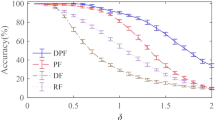Abstract
This paper presents a new particle pairing algorithm using “Genetic Algorithms” for DPIV (Digital Particle Image Velocimetry), which are searching algorithms for obtaining an optimal solution based on the mechanism of evolution. The particle pairing between two tracer images with a constant time interval is needed to obtain a velocity vector field. Since the algorithm adopts a fitness function which totally evaluates the similarity between respective small particle patterns in the two tracer images over the field, it promises to give a more correct velocity vector distribution than the conventional PTV (Particle Tracking Velocimetry) which identifies each particle based on its local information. In addition, a particle pattern matching for the similarity is performed after correcting fluid rotation. It therefore is robust against a high particle density and an increase in the time interval. The algorithm is applied to the PIV standard images distributed through the Internet (http://www.vsj.or.jp/piv). It gives a correct velocity vector distribution as a result even if a pair of the successive images has a large time interval.
Similar content being viewed by others
References
Etoh, T. and Takehara, K., Development of a New Algorithm and Supporting Technology for PIV, Proc. of The International Workshop on PIV’95-Fukui, Fukui, Japan, (1995), 91-106.
Goldberg, D. E., Genetic Algorithms in Search, Optimization, and Machine Learning, (1989), Addison-Wesley Publishing Company.
Kobayashi, T., Saga, T., Segawa, S. and Kanda, H., Development of a Real-Time Velocity Measurement System for Flow Fields Using a Digital Image Processing Technique, Trans. of JSME, (B), 55–509 (1989), 107–114.
Ohmi, K. and Lam, D. H., New Particle Tracking PIV Using an Improved Relaxation Method, CD Rom Proc. of 8th International Symposium on Flow Visualization, Sorrent, Italy, (1998), 209.
Ohyama, R., Takagi, T., Tsukiji, T., Nakanishi, S. and Kaneko, K., Particle Tracking Technique and Velocity Measurement of Visualized Flow Fields by means of Genetic Algorithm, J. of Visualization Society of Japan, 13-Suppli. 1 (1993), 35–38.
Okamoto, K., Hassan, Y. A. and Schmidt, W. D., New Tracking Algorithm for Particle Image Velocimetry, Experiment in Fluids, 19 (1995), 342–347.
Okamoto, K., Nishio, S., Kobayashi, T. and Saga, T., Standard Images for Particle Imaging Velocimetry, Proc. of The Second International Workshop on PIV’97-Fukui, Fukui, Japan, (1997), 229-236.
Shen, J. and Meng, H., A 3D Velocity Field Extraction Technique Using Genetic Algorithm, Proc. of The Second International Workshop on PIV’97-Fukui, Fukui, Japan, (1997), 43-50.
Uemura, T., Yamamoto, F. and Koukawa, M., High-Speed Algorithm for Particle Tracking Velocimetry Using Binary, J. of Visualization Society of Japan, 10–38 (1990), 58–64.
Author information
Authors and Affiliations
Corresponding author
Additional information
Ichiro Kimura: He received his M.S. degree in instrumentation engineering from Kobe University, Kobe, Japan in 1972 and his Dr.E. degree in mechanical engineering for industrial machinery from Osaka University, Osaka, Japan, in 1983. He was a Research Associate from 1972 to 1984 and an Associate Professor from 1984 to 1993 of Instrumentation Engineering at the Faculty of Engineering, Kobe University. He is currently a Professor of Electromechanical Engineering at Osaka Electro-Communication University, Osaka, Japan. He has been engaged in research on quantitative flow visualization using image processing and information processing on human sensibility. He is a member of the American Society of Mechanical Engineers, the Society of Instrument and Control Engineers, the Robotics Society of Japan, the Visualization Society of Japan, etc.
Atsuhiko Hattori: He received his B.S. degree in electromechanical engineering in 1996 and his M.S. degree in mechanical and control engineering in 1998 at Osaka Electro-Communication University, Osaka, Japan. He currently works for Culture Convenience Club Co., Ltd.
Masataka Ueda: He received his B.S. degree in electromechanical engineering at Osaka Electro-Communication University, Osaka, Japan in 1998.
Rights and permissions
About this article
Cite this article
Kimura, I., Hattori, A. & Ueda, M. Particle pairing using genetic algorithms for PIV. J Vis 2, 223–228 (2000). https://doi.org/10.1007/BF03181439
Received:
Revised:
Issue Date:
DOI: https://doi.org/10.1007/BF03181439




